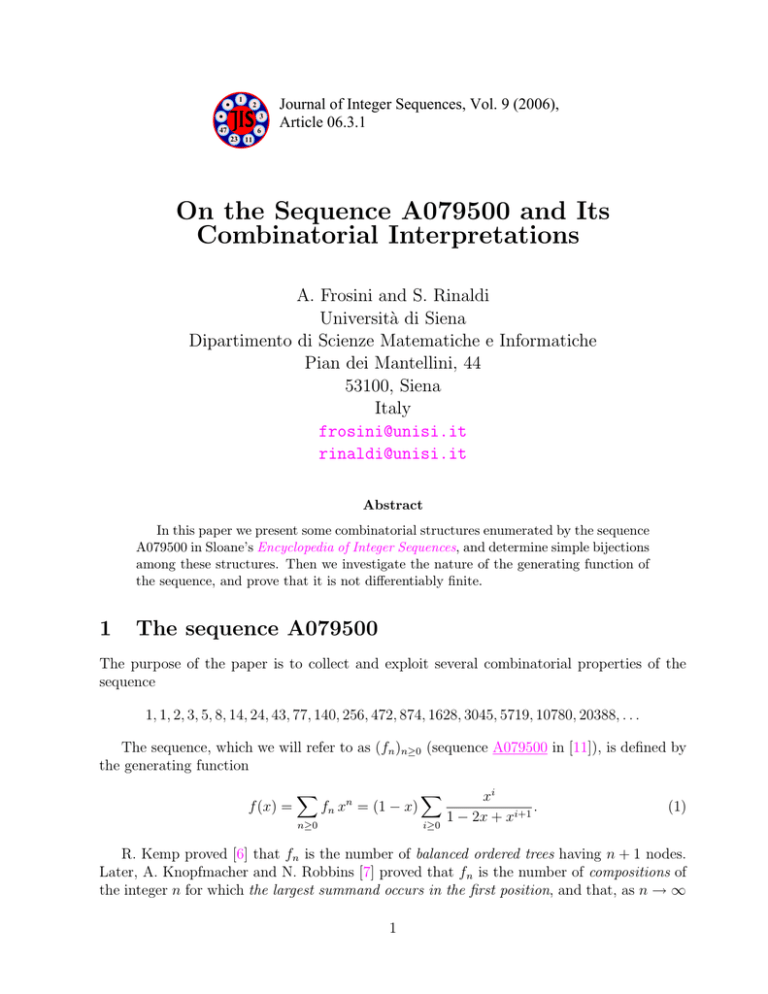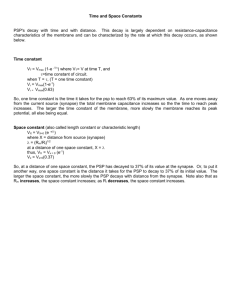On the Sequence A079500 and Its Combinatorial Interpretations
advertisement

1
2
3
47
6
Journal of Integer Sequences, Vol. 9 (2006),
Article 06.3.1
23 11
On the Sequence A079500 and Its
Combinatorial Interpretations
A. Frosini and S. Rinaldi
Università di Siena
Dipartimento di Scienze Matematiche e Informatiche
Pian dei Mantellini, 44
53100, Siena
Italy
frosini@unisi.it
rinaldi@unisi.it
Abstract
In this paper we present some combinatorial structures enumerated by the sequence
A079500 in Sloane’s Encyclopedia of Integer Sequences, and determine simple bijections
among these structures. Then we investigate the nature of the generating function of
the sequence, and prove that it is not differentiably finite.
1
The sequence A079500
The purpose of the paper is to collect and exploit several combinatorial properties of the
sequence
1, 1, 2, 3, 5, 8, 14, 24, 43, 77, 140, 256, 472, 874, 1628, 3045, 5719, 10780, 20388, . . .
The sequence, which we will refer to as (fn )n≥0 (sequence A079500 in [11]), is defined by
the generating function
f (x) =
X
fn xn = (1 − x)
n≥0
X
i≥0
xi
.
1 − 2x + xi+1
(1)
R. Kemp proved [6] that fn is the number of balanced ordered trees having n + 1 nodes.
Later, A. Knopfmacher and N. Robbins [7] proved that fn is the number of compositions of
the integer n for which the largest summand occurs in the first position, and that, as n → ∞
1
fn ∼
2n
(1 + δ(log2 n)),
n log 2
where δ(x) is a continuous periodic function of period 1, mean zero, and small amplitude of
which the authors determined the Fourier expansion; in the same paper they proved the nice
property that the coefficient fn is odd if and only if n = m2 − 1, or n = m2 , with m ≥ 1.
In 2001 Marc Le Brun defined the “numbral arithmetic” for binary sequences by replacing
addition with binary bitwise inclusive-OR, and multiplication by shift-&-OR (to the authors’
knowledge the only references on numbral arithmetic can be found on Sloane’s database [11].
For the basic definitions, see sequence A048888; for further properties see also sequences
A057892, A067139, A067150, A067399, and A067398. He conjectured that (fn )n≥1 counts
the number of divisors of the binary expansion of 2n − 1. The conjecture was confirmed by
Richard Schroeppel in the same year.
Later, the sequence (fn )n≥1 appears in the context of the enumeration of exact polyominoes, i.e., polyominoes that tile the plane by translation [1]. In particular, Brlek, Frosini,
Rinaldi, and Vuillon [4] proved that fn is the number of pseudo-square parallelogram polyominoes with flat bottom having semi-perimeter equal to n + 1.
Our aim in this paper is to give combinatorial evidence for these facts by showing bijections between the four classes enumerated by the sequence A079500.
In the last section we study the sequence from an analytical point of view, and investigate
the nature of its generating function f (x), proving that it is not differentiably finite (or Dfinite) [12].
The generating functions of the most common solved models in mathematical physics
are differentiably finite, and such functions have a rather simple behavior (for instance, the
coefficients can be computed quickly in a simple way, they have a nice asymptotic expansion,
they can be handled using computer algebra). On the contrary, models leading to non Dfinite functions are usually considered “unsolvable” (see [9, 10]).
Recently many authors have applied different techniques to prove the non D-finiteness
of models arising from physics or statistics [2, 3, 10]. Guttmann [9] developed a numerical
method for testing the “solvability” of lattice models based on the study of the singularities
of their anisotropic generating functions. In many cases the tests allow to state that the
examined model has not a D-finite generating function [10].
2
Four classes enumerated by A079500
In this section we define the four classes of combinatorial objects that we consider in this
paper, and then we prove, using bijective arguments, that they are enumerated by the
sequence A079500.
2.1
Pseudo-square parallelogram polyominoes
In the plane Z × Z a cell is a unit square, and a polyomino is a finite connected union of
cells having no cut point. Polyominoes are defined up to translations. A column (row) of
a polyomino is the intersection between the polyomino and an infinite strip of cells whose
2
centers lie on a vertical (horizontal) line. In a polyomino the perimeter is the length of
its boundary and the area is the number of its cells. For the main definitions and results
concerning polyominoes we refer to [12].
A particular subclass of the class of convex polyominoes consists of the parallelogram
polyominoes, defined by two lattice paths that use north (vertical) and east (horizontal)
unitary steps, and intersect only at their origin and extremity. These paths are commonly
called the upper and the lower path. Without loss of generality we assume that the upper
and lower path of the polyomino start in (0, 0). Figure 1 depicts a parallelogram polyomino
having area 14 and semi-perimeter 10. Note that for parallelogram polyominoes the semiperimeter is equal to the sum of the numbers of its rows and columns.
Figure 1: A parallelogram polyomino, its upper and lower paths.
The boundary of a parallelogram polyomino is conveniently represented by a boundary
word defined on the alphabet {0, 1}, where 0 and 1 stand for the horizontal and vertical
step, respectively. The coding follows the boundary of the polyomino starting from (0, 0) in
a clockwise orientation. For instance, the polyomino in Figure 1 is represented by the word
11011010001011100010.
If X = u1 . . . uk is a binary word, we indicate by X the mirror image of X, i.e., the word
uk . . . u1 , and the length of X is |X| = k. Moreover |Y |0 , (resp., |Y |1 ) indicates the number
of occurrences of 0s (resp. 1s) in Y .
Beauquier and Nivat [1] introduced the class of pseudo-square polyominoes, and proved
that each polyomino of this class may be used to tile the plane by translation. Indeed, let
A and B be two discrete points on the boundary of a polyomino P . Then [A, B] and [A, B]
denote respectively the paths from A to B on the boundary of P traversed in a clockwise and
counterclockwise way. The point A0 is the opposite of A on the boundary of P and satisfies
|[A, A0 ]| = |[A0 , A]|. A polyomino P is said to be pseudo-square if there are four points
A,B,A’,B’ on its boundary such that B ∈ [A, A0 ], [A, B] = [B 0 , A0 ], and [B, A0 ] = [A, B 0 ] (see
Figure 2).
3
B
A’
A
B’
Figure 2: A pseudo-square polyomino, its decomposition and a tiling of the plane determined
by the polyomino.
Here we consider the class PSP of parallelogram polyominoes which are also pseudosquares (briefly, psp-polyominoes) [4].
Proposition 2.1. If X Y X Y is a decomposition of the boundary word of a psp-polyomino
then:
i) XY encodes its upper path, and Y X its lower path;
ii) X = 1X 0 1, Y = 0Y 0 0, for some X 0 , Y 0 ∈ {0, 1};
iii) the decomposition X Y X Y is unique.
Y
A’
B
X
X
A
Y
B’
Figure 3: A psp-polyomino, and its unique decomposition.
For instance, the polyomino in Figure 3 can be decomposed as 111101·0100·101111·0010,
where X = 111101, Y = 0100.
We call psp-polyominoes with flat bottom those psp-polyominoes such that the word Y
(called the bottom) is made only of 0’s (see Figure 4). We denote by PSP − the class of such
polyominoes, and by PSP −
n,k those having bottom of length k ≥ 1, and semiperimeter n + 1.
The enumeration problem for the class PSP − is solved in [4], and here we recall the useful
characterization which leads to such a result:
Proposition 2.2. The word U = 1 X 0 1 0k , with k ≥ 1, and |U | = n + 1, represents the
0
j
upper path of a polyomino in PSP −
n,k if and only if X does not contain any factor 0 , with
j ≥ k.
4
Example 2.1. The word 110010001110100110001 represents the upper path of a polyomino
in PSP −
24,4 , as shown in Figure 4 (a), while the word 101100000101 does not encode a
polyomino in PSP −
15,4 since it contains the factor 00000 (as shown in Figure 4 (b)).
Y
Y
X
X
X
X
Y
Y
(a)
(b)
Figure 4: Examples of a polyomino in PSP −
24,4 (a), and a polygon which is not a polyomino,
(b)
2.2
Balanced ordered trees
For the basic definitions of the ordered trees we refer to [12]. An ordered tree is said to be
balanced if all its leaves are at the same level. Let Bn be the class of balanced ordered trees
having n + 1 nodes. In [6] R. Kemp proves that |Bn | = fn , n ≥ 0.
level
0
1
2
3
4
5
Figure 5: The eight balanced ordered trees having 6 nodes.
2.3
Compositions with the largest part in the first position
For any n ≥ 1, k ≥ 1 let Cn,k be the set of compositions of n having the largest part k in the
first position, i.e.,
k + a1 + . . . + ah = n,
with k ≥ a1 , . . . , ah ≥ 1, and h ≥ 0. For instance,
©
ª
C5,2 = 2 + 1 + 1 + 1, 2 + 2 + 1, 2 + 1 + 2 .
S
Moreover let Cn = nk=1 Cn,k be the set of compositions of n having the largest part in
the first position. For instance,
©
ª
C5 = 1 + 1 + 1 + 1 + 1, 2 + 1 + 1 + 1, 2 + 2 + 1, 2 + 1 + 2, 3 + 2, 3 + 1 + 1, 4 + 1, 5 .
5
By convention we set |C0 | = |C1 | = 1. In [7] A. Knopfmacher and N. Robbins prove that
for any n ≥ 0, |Cn | = fn .
Divisors of 2n − 1 in numbral arithmetic
2.4
Let n be an integer number, and let [n] be its binary representation. The numbral arithmetic relies on the replacing of the standard addition for binary sequences with binary
bitwise inclusive-OR. As a consequence, the multiplication uses the shift-&-OR instead of
the standard shift-&-add. As an example, it holds
[3] + [9] = 1 1 + 1 0 0 1 = 1 0 1 1 = [11]
[3] ∗ [9] = 1 1 ∗ 1 0 0 1 = 1 1 ∗ 1 + 1 1 0 ∗ 0 + 1 1 0 0 ∗ 0 + 1 1 0 0 0 ∗ 1 =
= 1 1 + 0 0 0 + 0 0 0 0 + 1 1 0 0 0 = 1 1 0 1 1 = [27].
Clearly, the defined addition and multiplication are still commutative.
We say that [d] divides [n] if there exists [e] such that [d] ∗ [e] = [n]. One can apply the
given definitions to compute the six divisors of [14], i.e., [1], [2], [3], [6], [7], and [14], in order
to immediately relying that the element [e] whose product with [d] is [n] is, in general, not
unique.
Let us define Dn to be the set of the divisors of [2n − 1] (i.e., the binary sequence 1n ),
and Dn,k the divisors of [2n − 1] having length k. We will show that, for each n > 0, the
cardinality of the set Dn is fn , by bijectively prove that |Dn,k | = |PSP −
n,n−k+1 |. In the
n
following table the divisors of [2 − 1], for n = 1, . . . , 4, are computed.
[4
n −1
divisors of [ 4
n −1
n
[2n − 1]
divisors of [2n − 1]
1
1
{1}
1
{1}
2
1 1
{ 1 , 1 1}
1 0 1
{ 1 , 1 0 1}
3
1 1 1
{ 1 , 11 , 111 }
10 10 1
{ 1 , 101 , 1 0 101 }
4
1 1 1 1
½
1, 11, 111
101, 1111
¾
3
]
10 10 1 01
n
½
3
]
1, 101, 10101
10001, 10100101
¾
For the same values of n, the numbers [ 4 3−1 ] (sequence A002450 in [11]) and their corresponding divisors are also shown. This sequence has two interesting combinatorial interpretations: for n > 0, it counts both the degree (n − 1) numbral power of 5, and the partial
sums of the first (n − 1) powers of 4, and it is also strictly connected with the sequence
A079500, as stated in the following:
6
Proposition 2.3. The binary sequence x1 x2 . . . xk is a divisor of [2n − 1] if and only if the
n
binary sequence x1 0 x2 0 . . . 0 xk is a divisor of [ 4 3−1 ].
3
Bijective results
First, we easily prove that the number of psp-polyominoes having semiperimeter n + 1 and
flat bottom, say PSP −
n , is fn . By Proposition 2.2 it follows that, for any fixed k ≥ 1, the
generating function of the psp-polyominoes having flat bottom of length k is
fk (x) =
xk
,
1 − x − x 2 − x3 − . . . − x k
(2)
hence the generating function of PSP − is given by the sum
1+
X
xi
1 X
f
(x)
=
(1
−
x)
,
k
x2 k≥1
1 − 2x + xi+1
i≥0
(3)
i.e., the generating function of A079500.
k=1
k=2
k=3
k=4
k=5
Figure 6: The eight psp-polyominoes with flat bottom having semi-perimeter equal to 6.
3.1
A bijection between Bn and PSP −
n
¯
¯
¯
We prove bijectively that |Bn | = ¯PSP −
n . We do this by establishing a bijection
Θ : Bn,k ½ PSP −
n,k .
where Bn,k denotes the set of trees in Bn having height equal to k, thus proving that this
class is counted by fk (x), i.e., the generating function in (2), for any k ≥ 1.
Let us start by observing that, for any k ≥ 1, each polyomino in PSP −
n,k has all the rows
of length k. Let T ∈ Bn,k , and let e1 , . . . , eh , h ≥ 1 be the leaves of T , from left to right, and
for any i = 1, . . . , h − 1 let ni be the level of node in T which is father of the leaves ei and
ei+1 , and has minimal level (clearly, 0 ≤ ni ≤ k − 1). Now Θ(T ) is defined as a polyomino
with h rows, each one with exactly k cells, and such that for any i = 1, . . . , h−1 the i+1 row
is placed just above the ith row, and moved on the right by k − ni − 1 cells (see Figure 7).
7
root
k− n i−1
ni
e i+1
ei
k
ei
e i+1
k
(a)
(b)
Figure 7: The bijection between trees in Bn,k , (a), and polyominoes in PSP −
n,k , (b).
The reader can easily check that Θ(T ) ∈ PSP −
n,k , and that Θ is a bijective function;
moreover from the definition of Θ it follows that the number of rows of Θ(T ) is equal to the
number of leaves of T (see Figure 8).
e1
e2 e3
e4 e5
e6
Figure 8: A balanced tree of height 3 and the corresponding polyomino with bottom of
length 3.
3.2
A bijection between PSP −
n and Cn
In this paragraph we will describe a bijection between PSP −
n,k and Cn,k , for any k ≥ 1, as
follows:
∆ : PSP −
n,k ½ Cn,k .
Let us consider a polyomino P in PSP −
n,k , and let the word encoding its upper path be
1 0 e1 1 0 e2 . . . 1 0 eh 1 0 k ,
with e1 + . . . + eh + (h + 1) + k = n + 1 and, by Proposition 2.2, ei < k, for i = 1, . . . , h. Let
us define
∆(P ) = k + (e1 + 1) + . . . + (eh + 1).
Clearly ∆(P ) is a composition of k + e1 + . . . + eh + h = n having k as leading summand,
thus ∆(P ) ∈ Cn,k . Moreover, if the polyomino P has h rows, h ≥ 1, then the corresponding
composition ∆(P ) has h parts.
8
For instance, the polyomino in Figure 8 (with semi-perimeter 13, bottom of length 3, and
6 rows) is represented by the word 1010110011000, i.e., 101 101 100 102 100 103 , and is mapped
through ∆ in the composition 3 + 2 + 2 + 1 + 3 + 1 of 12, with greatest summand 3 and
having 6 parts. It is easy to check that ∆ is a bijection.
The table below shows the correspondences between several parameters in polyominoes
of PSP − , balanced ordered trees, and compositions with the largest summand in the first
position.
3.3
PSP −
semi-perimeter + 1
length of the bottom
number of rows
B
number of nodes +1
height of the tree
number of leaves
C
sum of the terms
leading summand
number of summands
A bijection between Dn and PSP −
n
−
We achieve |Dn | = |PSP −
n | by defining a bijection Ω between Dn,k and PSP n,n−k+1 . The
following characterization of the elements of Dn is needed.
Lemma 3.1. For each n, d > 0, it holds that [d] is a divisor of [2n − 1] if and only if it ends
with the digit 1, and it does not contain any subsequence of 0s having length greater than
n − k, with k being the length of [d].
Proof. (⇒) Let [d] = d1 d2 . . . dk , [e] = e1 e2 . . . en−k+1 , and [d] ∗ [e] = [2n − 1] = 1n (where
the power notation stands for repetition). By definition, it holds that
[d] ∗ [e] = d1 . . . dk−1 0 ∗ en−k+1 + . . . + d1 . . . dk−1 0 0n−k ∗ e1 = p1 . . . pn .
We proceed by contradiction and we assume that dk = 0 or that there exists in [d] a sequence
of 0s having length n − k + 1.
In the first case, it turns out that the digit pn has value 0 since it is the sum (i.e., the
inclusive-OR) of n − k + 1 digits of value 0, and this is not possible.
In the second case, we assume that [d] = 1 d2 . . . dk−1 1 contains the sequence of 0s
dh . . . dh+n−k . By definition, the digit pn−h of the product [d] ∗ [e] has value 0, since it
is the sum of n − k + 1 bits having value 0. Again this is not possible by the hypothesis
[d] ∗ [e] = 1n .
(⇐) Let us consider the binary sequence [e] = 1n−k+1 . Since [d] = 1 d2 . . . dk−1 1 does
not contain any sequence of 0s having length greater than n − k, then each digit p1 . . . pn of
the product [d] ∗ [e] is the sum of n − k + 1 digits at least one of them having value 1, so it
has value 1. The thesis [d] ∗ [e] = 1n is achieved.
9
We define the bijection
Ω : Dn,k ½ PSP −
n,n−k+1
as follows: to each divisor [d] = 1 d2 . . . dk−1 1 of [2n −1] we associate a psp-polyomino whose
upper path is represented by 1 d2 . . . dk−1 1 0n−k+1 .
By Lemma 3.1, each divisor of [2n − 1] has no subsequences of 0s of length greater than
n−k, so, by Proposition 2.2, it encodes an upper path of a psp-polyomino having the bottom
of length greater than n − k + 1. The minimal possible semi-perimeter for such polyominoes
is n + 1, as desired. On the contrary, the word coding the upper path of a polyomino in
n−k+1
PSP −
, with w1
n,n−k+1 belongs to Dn,k , since it is a binary sequence of the type w1 0
starting and ending with the digit 1, and containing no sequences of 0s of length greater
than n − k.
Figure 9 shows the correspondence between the eight divisors of [25 − 1] and the eight
psp-polyominoes in PSP −
5.
PSP 5,1
11111
D 5,5
PSP 5,2
1111
1011
PSP 5,4
PSP 5,3
1101
111
D 5,4
101
D 5,3
PSP 5,5
11
1
D 5,2
D 5,1
Figure 9: Each upper path of an element in PSP −
5 is associated with the correspondent
divisor of [2n − 1] in D5 .
4
Nature of the generating function
Finally, for the sake of completeness, we would like to spend a few words on investigating
the nature of the generating function f (x) of the sequence A079500.
Let us start by recalling that a formal power series u(x) with coefficients in C is said to
be differentiably finite (briefly, D-finite) if it satisfies a (non-trivial) polynomial equation
qm (x)u(m) + qm−1 (x)u(m−1) + . . . + q1 (x)u0 + q0 (x)u = q(x),
with q0 (x), . . . , qm (x) ∈ C[x], and qm (x) 6= 0 ([12], Ch. 6).
Every algebraic series is D-finite, while the converse does not hold. For example, the gen¡ ¢2
erating function u(x) of the sequence 2n
is D-finite, since it satisfies the linear differential
n
equation
4u(x) + (32x − 1)u0 (x) + x(16x − 1)u00 (x) = 0,
10
while u(x) is not algebraic, as proved for the first time in [8].
Our aim in this section is to prove that the generating function of the sequence A079500,
f (x) = (1 − x)
X
i≥0
xi
1 − 2x + xi+1
is not differentiably finite.
In order to do this we can use the very simple argument, arising from the classical theory
of linear differential equation, that a D-finite power series of a single variable has only a finite
number of singularities. Thus we can reach our goal by proving that f (x) has infinitely many
poles. For instance, the function 1/ cos(x) is not D-finite, since it has an infinite number of
singularities.
We point out that this “criterion” was applied by Flajolet in [8] to prove that the language
{ an bv1 an v2 : n ≥ 1, v1 , v2 ∈ {a, b}∗ }
is a context-free inherently ambiguous language.
We reach our goal by adapting Flajolet’s proof to our case. For each i ≥ 1, let Pi =
1 − 2x + xi+1 . For |x| < 1, it is easy to check that each Pi has a real zero ρi such that
1
< ρi < 1. By the Principle of the Argument and by the related Rouché’s Theorem we are
2
able to state that for a sufficiently small x, say |x| < 34 , ρi is the unique zero of Pi . Thus we
have
1. if i > j then ρi < ρj ;
2. limi→∞ ρi = 21 .
P
Hence, for any x 6= ρi , 12 , and |x| < 43 the series i≥0 P1i is convergent. As a conclusion,
f (x) is analytic in |x| < 34 except for finitely many poles ρi which accumulate in 21 , thus it is
not D-finite.
It is interesting to observe that, while parallelogram polyominoes are one of easiest (and
most frequently treated in literature) classes of polyominoes, and have an algebraic generating function according to the semi-perimeter, psp-polyominoes with a flat bottom (which
are a rather simple type of parallelogram polyominoes) are not D-solvable.
On the nature of a class of languages. The result in the present section suggests some
further considerations regarding the class PSP − of psp-polyominoes with flat bottom.
By Proposition 2.2 we have that the class of the polyominoes having bottom of length k ≥
1 can be suitably encoded by means of the regular language `k defined by the unambiguous
regular expression
¡
¢∗
1 1 ∪ 01 ∪ 001 ∪ . . . ∪ 0k−1 1 0k ,
S
and that consequently the class PSP − can be encoded by means of the language ` = k≥1 `k .
A classical result by Chomsky and Schützenberger [5] states that the generating function
of an unambiguous context-free language is algebraic. But, as we have proved in the present
section, the generating function of ` (i.e., x2 f (x)) is not algebraic (actually, not even Dfinite), thus ` is an inherently ambiguous language.
11
References
[1] D. Beauquier, M. Nivat, On translating one polyomino to tile the plane, Discrete Comput. Geom. 6 (1991) 575–592.
[2] M. Bousquet-Mélou, Marko Petkovsek, Walks confined in a quadrant are not always
D-finite, Theoret. Comput. Sci. 307 (2003) 257–276.
[3] M. Bousquet-Mélou, A. Rechnitzer, The site-perimeter of bargraphs, Advances in
Applied Mathematics, 31 (2003) 86–112.
[4] S. Brlek, A. Frosini, S. Rinaldi, L. Vuillon, Tilings by translation: enumeration by a
rational language approach, Electronic Journal of Combinatorics 13 (1) (2006) #R15.
[5] N. Chomsky, M. P. Schützenberger, The algebraic theory of context-free languages,
In P. Braffort and D. Hirschberg, eds., Computer Programming and Formal Systems,
North-Holland, Amsterdam, 1963, pp. 118–161.
[6] R. Kemp, Balanced ordered trees, Random Structures and Alg. 5 (1994) 99–121.
[7] A. Knopfmacher, N. Robbins, Compositions with parts constrained by the leading
summand, Ars Combinatorica, 76 (2005), 287–295.
[8] P. Flajolet, Analytic models and ambiguity of context-free languages, Theoret. Comput.
Sci. 49 (1987) 283–309.
[9] A. J. Guttmann, Indicators of solvability for lattice models, Discrete Mathematics 217
(2000) 167–189.
[10] A. Rechnitzer, Haruspicy and anisotropic generating functions, Advances in Applied
Mathematics, 30 (2003) 228–257.
[11] N. J. A. Sloane, The On-Line Encyclopedia of Integer Sequences, published electronically at h http://www.research.att.com/∼njas/sequences/i.
[12] R. P. Stanley, Enumerative Combinatorics, Vol. 2, Cambridge University Press, Cambridge, 1999.
2000 Mathematics Subject Classification: Primary 05A15; Secondary 05B50, 05B45.
Keywords: Tiling with polyominoes, balanced tree, numbral arithmetic, generating function.
(Concerned with sequences A002450, A048888, A057892, A067139, A067150, A067398, A067399,
and A079500.)
12
Received January 11 2006; revised version received July 19 2006 Published in Journal of
Integer Sequences, July 19 2006.
Return to Journal of Integer Sequences home page.
13





